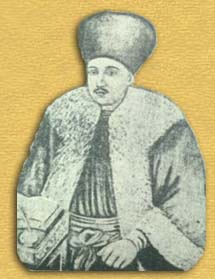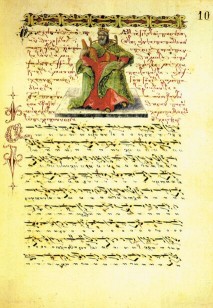Gregory Protopsaltes the Byzantios
![]()
His life and his work

Gregory was a music genious, a musician and a teacher of music, a deep mystic of the art of music, both ecclesiastical and external. He is one of the three Teachers of the New Method of analytic notation of Byzantine Music, which was introded by the 1814 reform. As a Lambadarios and an Archcantor of the Great Church, he constitutes the critical measure regarding the importance of the change of the musical notation, but also for the unchangeable of the music itself, which with the revised notation only changed its external vestement.
This importance of Gregory's role is vividly manifested, when we want to talk about the work of any melodist before 1814, because we are forced to see it via the explaination of Gregory or of Chourmouzios Chartophylax. But let us first lay down the biography of Gregory according to the facts provided by research.
According to one tradition, Gregory was born in Constantinople on the same day that Peter Lambadarios the Peloponnesian died (1777 or 1778). His father was a priest, named George, and his mother's name was Helen. The surname «Levites», which is attributed to him, is probably incorrect, but was given to him because his father was a priest, a «Levite» in the Old Testament. The probable day for his death is the 23rd December 1821, when Constantine succeeded him as the Archcantor, but other sources talk about 1820 or, more often, 1822. In any case, he died very young, at the peak of his age and of his work; he was at most 43 years old.
From his youth he learned the Armenian language and music, because he liked going to the Armenian Church. In order to eloign him from there, his father sent him to the abbot of the Sinai Metochion at Valata, the Cretan Archandrite Jeremias, where Gregory learned the Greek letters and, because of his nice voice, became a Reader and a Cantor.
Gregory became a passionate music student of many cantors, including Iakovos Protopsaltes, Peter Protopsaltes the Byzantios, and, finally, George the Cretan. It seems that during the time that Peter Byzantios was Archcantor, namely during 1800-1805, Gregory is also in the Patriarchate, if not as a Lambadarios, at least as the First Domestikos, and chanted together with his tacher. Certainly though, around 1810, Gregory was the Lambadarios of the Great Church when Manuel was the Protopsaltes.
In the period 1800-1805, Gregory got married and had children, but we do not know their precise number. Constantine Psachos talks about the last daughter of Gregory, who in 1897 was 90 years old.
From Lambadarios, Gregory became Protopsaltes after the death of Manuel, on the 21st June 1891. As an Archcantor, he chanted for 2 ½ years, until his death on the 23rd December 1821.
In 1814, there happened the historic reform on the byzantine music notation, which was deemed to be a «benefaction of Nation». The reform was carried out by three excellent musicians of the time, namely Gregory, archmandrite Chrysantos, and Chourmouzios Chartophylax. These three Teachers, as they are readily referred to, discussed thoroughly and systematized into a single method the theory of Byzantine Music. What they mostly paid attention to, and through which they became «benefactors of the Nation» was the explaination of the old notation, and the transcription of the pre-1814 melodies into their new notation.
This New Method of teaching and learning Byzantine music was submitted to the Patriarchate. The Holy Synod under Patriarch Cyril VII assembled on purpose to discuss the issue, and the most esteemed members of the Nation were invited.
The Synod was convinced by the reasons and the proofs of the three music teachers regarding the canonisation of the music art (because there was initial suspicion that the Teachers were supposedly inventing their own Psalmody). It decided that Gregory Lambadarios and Chourmouzios Chartophylax teach the practical part of the Ecclesiastical Music, whereas the Archmandrite Chrysanthos the theory.
Very illuminating on this subject is a letter sent by Dionysios the Vatopedinos from Constantinople to the Monastery of Vatopedion on the 21st of January 1815. According to this, a common School was founded at the Sinai Metochion and teaches a new scientific method of music with rules and grammar. Teachers in this school are a monk Chrysanthos and the Lambadarios of the Great Church [i.e. Gregory], and there are more than 200 students which attend this School every day. Among these, there are Hierarchs and Protosyggeloi, and deacons of Hierarchs, and many laymen.
The contribution of Gregory in the formation of the New Method was the canonisation and the explanation of the scales and the parachords, and the simple and correct analysis and transcription of the old notation into this new method.
With geat zeal after the reform , Gregory and Chourmouzios explained the work of the old teachers. And it is extraordinary how within six years, from 1815 until his death in 1821, he wrote almost 20 volumes of manuscripts with explanations of older byzantine melodies. From these volumes, he copied some twice and thrice in order to facilitate the spreading of the New Method.

Gregory has a special friendship with Patriarch Gregory V, for whose third elevation to the Throne he wrote two songs. As the Protopsaltes, he also lived with him all the agony and sadness during the Great Lent and the Holy Week, until the Pascha, 10th April 1821. For this last Holy Week of the two Gregories, we read the following: « By he [the Patriarch] quitely went to the Church and listened to the service of the customary vigils of the Holy Week (these were then sung in the morning, because which Christian dared to come out at night?), and many times the ever-blessed repeated to himself the beginning of the Troparion «Behold, the Bridegroom comes in the middle of the night...».
Gregory also had a special relation with the highest master of Moldabia, Mr Michael Soutzos of Gregory, to whom he offered three songs in 1820. Due to this relationship, his fame as a music teacher became widespread in Moldowallachia, and especially in Iasion and Bucarest, where his former students became teachers of music under the protection of the music-friendly directors.
The work of Gregory Protopsaltes can be split into three categories:
A. His own compositions
- 2 Polyelei (Δοῦλοι Κύριον καὶ Ἐπὶ τῶν ποταμῶν Βαβυλῶνος).
- A series of Argosyntomai Doxologies, δηλαδὴ 8, and two more in grave mode.
- A short doxology in grave mode.
- 4 slow doxologies (in the plagal modes)
.
- 3 series of cherubic humns (i.e. 24) - great, medium, and greatest.
- 3 daily cherubic hymns (στὴ σειρὰ Πέτρου Πελοποννησίου).
- 1 series of Communion hymns «Αἰνεῖτε» for Sundays.
- Communion hymns for feastdays in various modes.
- The weekday prokeimena and those of the Feasts of the Lord.
- Psalm 50 in mode II.
- The Typika of Divine Liturgy in mode IV legetos, fthoric.
- The compunctional stichera Τῆς μετανοίας - Τῆς σωτηρίας - Τὰ πλήθη τῶν πεπραγμένων μοι δεινῶν.
- The troparia sung at the end of the Hours.
- The Great Compline hymnsΤὰ τοῦ μεγάλου Ἀποδείπνου Ψυχή μου, ψυχή μου καὶ Παναγία Θεοτόκε.
- Κύριε ἐλέησον, slow in the plagal modes.
- The short troparia of the Bridegroom: Ἰδού ὁ νυμφίος - Ὅτε οἱ ἔνδοξοι...
- The slow kathismata of the Bridegroom services.
- The XV Antiphons of the service of the Passion in short sticheraric melody.
- A lesson, when the Hierarch is dressed «Περίζωσαι τὴν ῥομφαῖάν σου» with kratema.
- A kratema in grave mode.
- The Magnificat in mode pl. IV.
- The Katavasias of Lazaros, and the uncustomary Heirmoi of the Canon Ἀνοίξω τὸ στόμα μου and the fourth heirmos «Ἐποίησε κράτος» (of Lazaros).
- Two series of Ἄξιόν ἐστιν... (i.e. 16).
- The traditional melody of the Apostle and Gospel readings in mode IV.
B. His explanatory work
Gregory explained and transcribed into the new notation the following works fo the Melodists, especially of those of the XVIIth and XVIIIth centuries.
- All the works of Peter Bereketis (4 volumes).
- The Sticherarion of Germanos of New Patras (5 volumes).
- The Papadike of Peter Byzantios (the published 4-tome Pandektis) (5 volumes).
- The Kalophonic Heirmologion (1 volume).
- The Anastasimatarion of Peter the Peloponnesian (1 volume).
- The Heirmologion of Peter the Peloponnesian (1 volume).
- The short Heirmologion of Peter Byzantios (1 volume).
- The Doxastarion of Peter Byzantios (2 volumes).
- The Ekloge of the papadic chant (1 volume).
- The Ekloge of the sticheraric chant (1 volume).
- Various other lessons of various teachers.
C. Non-ecclesiastical songs
He also wrote about 30 songs, mostly similar in style as the turkish makamia. Notably, the manuscripts of many of his original compositions are subtitled with the note that the melody is «as they are sung in the Great Church of Christ». This constitutes a sign of the tradition of Gregory.
The work of Gregory dissiminates widely via many manuscripts and printed music books. All his personal work, except for the Apostle and Gospel in mode IV, has been published.
From his explanatory work, the following have been published: the four-tome Pandektis, the Kalophonic Heirmologion, the Anastasimatarion, the Heirmologion, and the Doxastarion of Peter the Peloponnesian, the Heirmologion of Peter Byzantios, and a few other lessons of various teachers.
And from the songs of Gregory, several are included in Efterpe and Pandora (1st tome).

